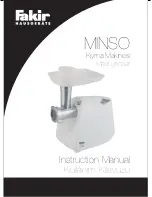
10
at the end of the sausage horn. Stop the
appliance. Make a knot in the overhanging
end of the sausage skin. Push the knot up
against the end of the sausage horn to avoid
any air being trapped in the sausage skin.
Start the appliance again and keep up the
supply of sausage meat. The sausage skin
will fit with meat. To avoid overstretching
the sausage skin, do not make your
sausages too fat. When all the sausage
meat has been used, stop the appliance,
pull the remaining sausage skin off the
sausage horn and tie a knot.
Making Kebbe:
1. Insert the worm shaft into the cutter housing,
the plastic end first.
Place the cone in the cutter housing. Place
the former on the cutter housing and screw
the ring on the cutter housing. (Make sure
the notches of the separator fit onto the
projections of the mincer head.). Turn the
screw ring in the direction of the arrow on
the cutter housing until it is properly fastened.
2. Attach the cutter housing to the motor unit.
3. Place the tray on the upright part of the
cutter housing.
4. Now the appliance is ready for making
kebbe.
Guide of Stuffed Kebbe:
Outer Casing:
500g lamb, cut into strips
500g washed and drained bulgur wheat
1 small onion
Pass alternate batches of lamb and bulgur
wheat through the mincer fitted with the fine
screen, adding the onion before all the lamb
and wheat are minced. Mix the minced lamb,
onion and wheat together then pass back
through the mincer a second time. If an
extra fine screen and mince the mixture for
a third time, alternatively continue mincing
using the fine screen. The mixture is now
ready to extrude through the kebbe maker
attachment.
Filling:
400 g lamb, cut into strips
15 ml/1 tbsp oil












